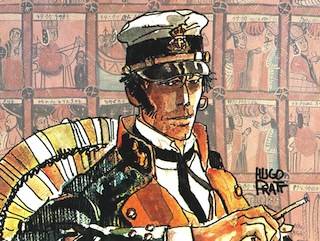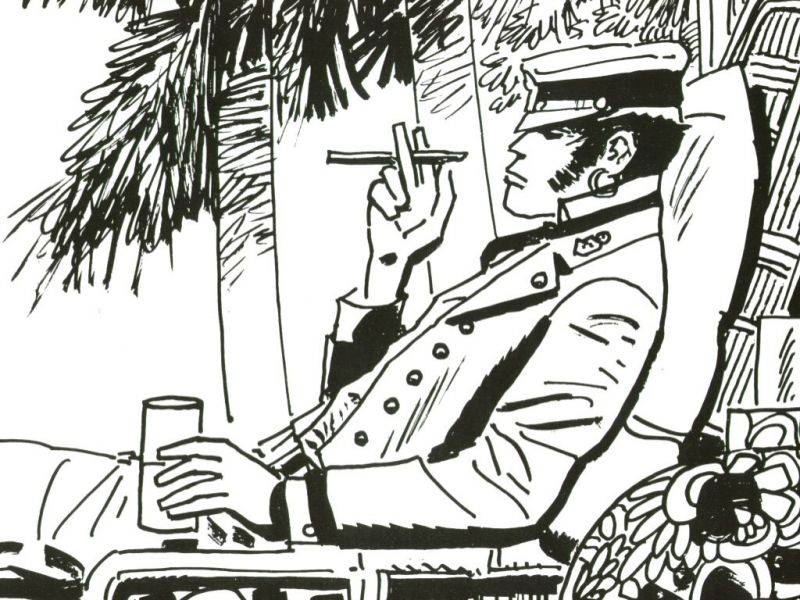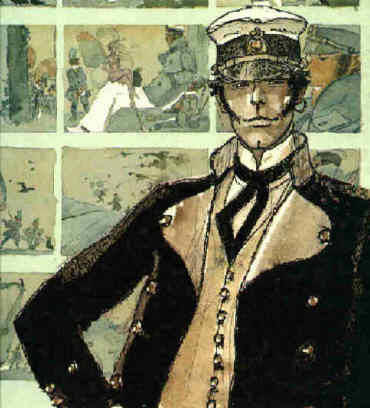Corto Maltese is Ready to Seize America
He is complex, aloof, with sharp cheekbones and a cascade of black hair. A “rogue with a heart of gold,” he is tolerant and sympathetic to the underdog. He is a man who, when he discovered that he had no fate line on his palm, carved his own with a razor, determining that his fate was his to choose and whose favorite book is Utopia by Thomas Moore... but he never finishes it.
He was born in Valletta, Malta, on July 10, 1887, the son of a British sailor from Cornwall and a gypsy Andalusian witch and prostitute known as “La Niña de Gibraltar.” He is a sailor-adventurer by the name of Corto Maltese, actually born to Italian comic book creator Hugo Eugenio Pratt in 1967, and he is about to conquer the United States where the graphic novel The Ballad of the Salt Sea is now available for the first time in over 20 years. Corto (in Buenos Aires slang, Corto means clever or shrewd) Maltese has enjoyed a colossal amount of popularity in Europe, particularly in France, for over 40 years and although the likes of Tim Burton and Frank Miller have been reported being big fans, he’s not well known in America... not yet! Rizzoli USA's new edition, translated by Hall Powell, Ian Monk's English translation for the mid-90s is currently out of print, appeals to fans of bold action-packed tales and sophisticated readers seeking elegant stories alike.
John Seven reports in Publishers Weekly “Rizzoli’s edition marks the first direct-from-Italian translation in English in the book’s history. The translator for this version is Hall Powell, a filmmaker and screenwriter for television shows like Law and Order. 'It’s a kind of a Biblical source,' Powell said. 'It was so important to all of my French and Italian friends that it was a serious undertaking.'Powell had lived in Italy when he was younger—he was Roman Polanski’s assistant for a period—and continued to visit throughout his life. One evening, he found himself in the same place as Patrizia Zanotti, Pratt’s longtime assistant and owner of the rights to all his work, when the conversation turned to a release of Corto Maltese for the American market and her quest for a translator.
'I told her why don’t I take a look at this and see how I feel about translating it,' Powell said. 'I sat with it for a week or so and ended up translating 20 or 25 pages, and about 48 hours later, she and Rizzoli had approved me. I was off and running.' Powell did the translation using Final Draft, which formatted it just like a movie script and allowed him to easily take into account the visuals that would shape the words. 'It probably went through five major pass-throughs thinking about how the language would fit in this country,' he said. 'As I began to see the comic panels and it began to get finalized, the translation changed because I began to look at the way he’d drawn things and it changed the meaning in certain places. It was fascinating, and all organic and all good.'” Patrizia Zanotti was also involved in the project as a colorist, indeed she colored the characters and foreground details.
Vik Gill, a reviewer on Amazon writes “The story is fantastic. It is set on the eve of, and then during World War I, in the Pacific Ocean. The story opens with Rasputin, a coarse privateer, coming across two shipwreck survivors--Pandora and Cain, members of a rich family--and immediately plotting to hold them for ransom. Corto Maltese is introduced shortly after as a man tied to a raft by his former crew, he is picked up by Rasputin, and the story goes into a more complicated plot of the movements of a group of pirates and thieves operating in the Pacific. The plot is entwined with the politics of the period--with the tensions between Britain and Germany in the months before World War I.
The politics of the story are never the primary focus, they are elements of the setting that drive the events of Ballad and the motivations of the characters--this is very much a high adventure story.”Pratt, a strong storyteller who crafted his stories with extensive imagination and precise historical research, devised his character when Malta had become independent of Britain. The country thus became the Mediterranean symbol of freedom and Corto Maltese embodies that view. Born in Rimini to Rolando Pratt, a professional Italian soldier, and Evelina Genero, Hugo Pratt himself had a quiet adventurous life.
He traveled the world, he moved Venice, Ethiopia, Argentina and London, was interned in a prison camp where he would buy comics from guards and later was sent back to Italy by the Red Cross and was at risk of being executed as SS troops had mistaken him for a South African spy. The Ballad of the Salt Sea is the first of a series of novels (29 total) and as the series continues Pratt shifted his attention to areas, like Ethiopia and Kazakhstan, that were barely considered at the time. He always did in-depth research for factual and visual details, and some characters are real historical figures or loosely based on them, like Corto's main opponent, Rasputin. Corto Maltese was ahead of his time indeed the themes of his stories are extremely contemporary.
“When you look at Occupy Wall Street now, and this general aspiration for real meaningful interaction and change for the disenfranchised, this guy embodied it. Corto lived it, he breathed it,” Powell said in his interview with John Seven.On a less political note, Corto Maltese has also been become a style symbol. Stephen Hayman writes in The New York Times: “Corto’s bravado struck a chord with the designer Joseph Altuzarra, who themed his latest fall-winter collection around the seafaring rake. 'My aunt gave me the comic books as a teenager, and I loved them,' said Altuzarra, who grew up in France, where these books are canonical. 'Corto Maltese was everything I wasn’t as a 13-year-old: elegant, confident, charismatic and mysterious.'
He says that a double-breasted navy peacoat from his collection — modeled by Joan Smalls during the February runway show in New York — was 'a play on a classic Corto look,' complete with a huge upturned collar. Altuzarra said that Gypsy references elsewhere in the collection were a nod to Corto’s mixed heritage.”





































i-Italy
Facebook
Google+
This work may not be reproduced, in whole or in part, without prior written permission.
Questo lavoro non può essere riprodotto, in tutto o in parte, senza permesso scritto.